Journal Publications
Treace Medical Concepts is dedicated to advancing the understanding of the Lapiplasty® Procedure and its benefits to patients, surgeons, and the healthcare system through research studies and publications in the peer-reviewed literature.

Multicenter Early Radiographic Outcomes of Triplanar Tarsometatarsal Arthrodesis With Early Weightbearing
Ray JJ, Koay J, Dayton PD, Hatch DJ, Smith B, Santrock RD
Foot Ankle Int. 2019 [published online ahead of print].
Summary: Multicenter, retrospective study of 57 hallux valgus (62 feet) patients treated with the Lapiplasty® Procedure and early return to weight-bearing (average 10.9 days post-op). At average follow-up of 13.5 months, the results demonstrated that 96.8% of study patients maintained their 3-plane bunion correction (Intermetatarsal Angle, Hallux Valgus Angle, and Tibial Sesamoid Position), and only 1.6% experienced a symptomatic non-union complication.
Link
Ray JJ, Koay J, Dayton PD, Hatch DJ, Smith B, Santrock RD
Foot Ankle Int. 2019 [published online ahead of print].
Summary: Multicenter, retrospective study of 57 hallux valgus (62 feet) patients treated with the Lapiplasty® Procedure and early return to weight-bearing (average 10.9 days post-op). At average follow-up of 13.5 months, the results demonstrated that 96.8% of study patients maintained their 3-plane bunion correction (Intermetatarsal Angle, Hallux Valgus Angle, and Tibial Sesamoid Position), and only 1.6% experienced a symptomatic non-union complication.
Link

Progression of Healing on Serial Radiographs Following First Ray Arthrodesis in the Foot Using a Biplanar Plating Technique Without Compression
Dayton P, Santrock R, Kauwe M, Gansen G, Harper S, Cifaldi A, Egdorf R, Eisenschink JJ
Foot Ankle Surg. 2019 [published online ahead of print]
Summary: Multicenter, retrospective study of bone healing with accelerated weightbearing protocol in patients undergoing TMT or MTP fusions with Lapiplasty® biplanar plating. 195 patients were included with mean follow up of 9.5 months. Patients were allowed to begin weightbearing on the operative foot approximately at post-op day 5. Results were 97.4% of patients demonstrated successful bony fusion and 98.9% maintained a stable joint position over the course of the study.
Link
Dayton P, Santrock R, Kauwe M, Gansen G, Harper S, Cifaldi A, Egdorf R, Eisenschink JJ
Foot Ankle Surg. 2019 [published online ahead of print]
Summary: Multicenter, retrospective study of bone healing with accelerated weightbearing protocol in patients undergoing TMT or MTP fusions with Lapiplasty® biplanar plating. 195 patients were included with mean follow up of 9.5 months. Patients were allowed to begin weightbearing on the operative foot approximately at post-op day 5. Results were 97.4% of patients demonstrated successful bony fusion and 98.9% maintained a stable joint position over the course of the study.
Link
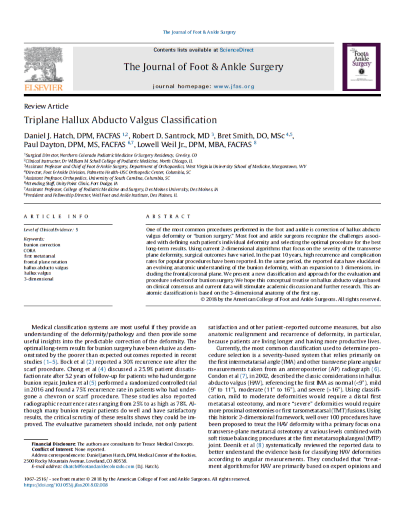
Triplane Hallux Abducto Valgus Classification
Hatch DJ, Santrock RD, Smith B, Dayton P, Weil L Jr.
J Foot Ankle Surg. 2018, 57:972–981.
Summary: Rather than the 2D hallux valgus classification systems traditionally referenced, this manuscript presents a novel 3-plane (3D) classification system for the evaluation and procedure selection for hallux valgus treatment.
Class 1 - No metatarsal rotation;
Class 2A - Metatarsal rotation without sesamoid subluxation;
Class 2B - Metatarsal rotation with sesamoid subluxation;
Class 3 - Metatarsus adductus bunion;
Class 4 - Degenerative (DJD) bunion.
Link
Hatch DJ, Santrock RD, Smith B, Dayton P, Weil L Jr.
J Foot Ankle Surg. 2018, 57:972–981.
Summary: Rather than the 2D hallux valgus classification systems traditionally referenced, this manuscript presents a novel 3-plane (3D) classification system for the evaluation and procedure selection for hallux valgus treatment.
Class 1 - No metatarsal rotation;
Class 2A - Metatarsal rotation without sesamoid subluxation;
Class 2B - Metatarsal rotation with sesamoid subluxation;
Class 3 - Metatarsus adductus bunion;
Class 4 - Degenerative (DJD) bunion.
Link
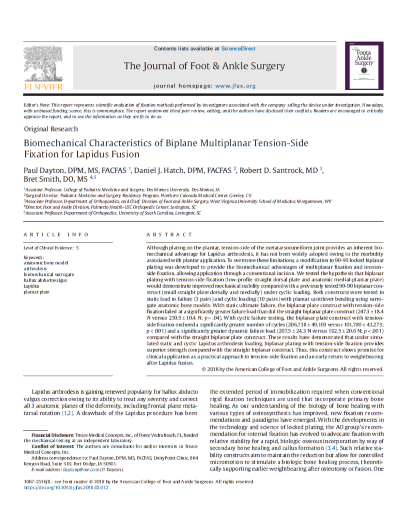
Biomechanical Characteristics of Biplane Multiplanar Tension-Side Fixation for Lapidus Fusion
Dayton P, Hatch DJ, Santrock RD, Smith B
J Foot Ankle Surg. 2018, 57:766-770.
Summary: Biomechanical study comparing the Lapiplasty® Plantar Python® tension-side fixation construct to Lapiplasty® Biplanar™ Plating, demonstrating a 17% improvement in maximum load to failure and a 103% increase in the cycles to failure (simulating post-operative weight-bearing).
Link
Dayton P, Hatch DJ, Santrock RD, Smith B
J Foot Ankle Surg. 2018, 57:766-770.
Summary: Biomechanical study comparing the Lapiplasty® Plantar Python® tension-side fixation construct to Lapiplasty® Biplanar™ Plating, demonstrating a 17% improvement in maximum load to failure and a 103% increase in the cycles to failure (simulating post-operative weight-bearing).
Link

Evidence-Based Bunion Surgery: A Critical Examination of Current and Emerging Concepts and Techniques
Dayton, Paul D. (Ed.)
Springer International Publishing [Textbook]. 2018.
Summary: This textbook provides a critical examination of the traditions and techniques commonly taught for bunion surgery and contrasts them with new, evidence-based anatomic and surgical concepts (including the Lapiplasty® Procedure).
Link
Dayton, Paul D. (Ed.)
Springer International Publishing [Textbook]. 2018.
Summary: This textbook provides a critical examination of the traditions and techniques commonly taught for bunion surgery and contrasts them with new, evidence-based anatomic and surgical concepts (including the Lapiplasty® Procedure).
Link
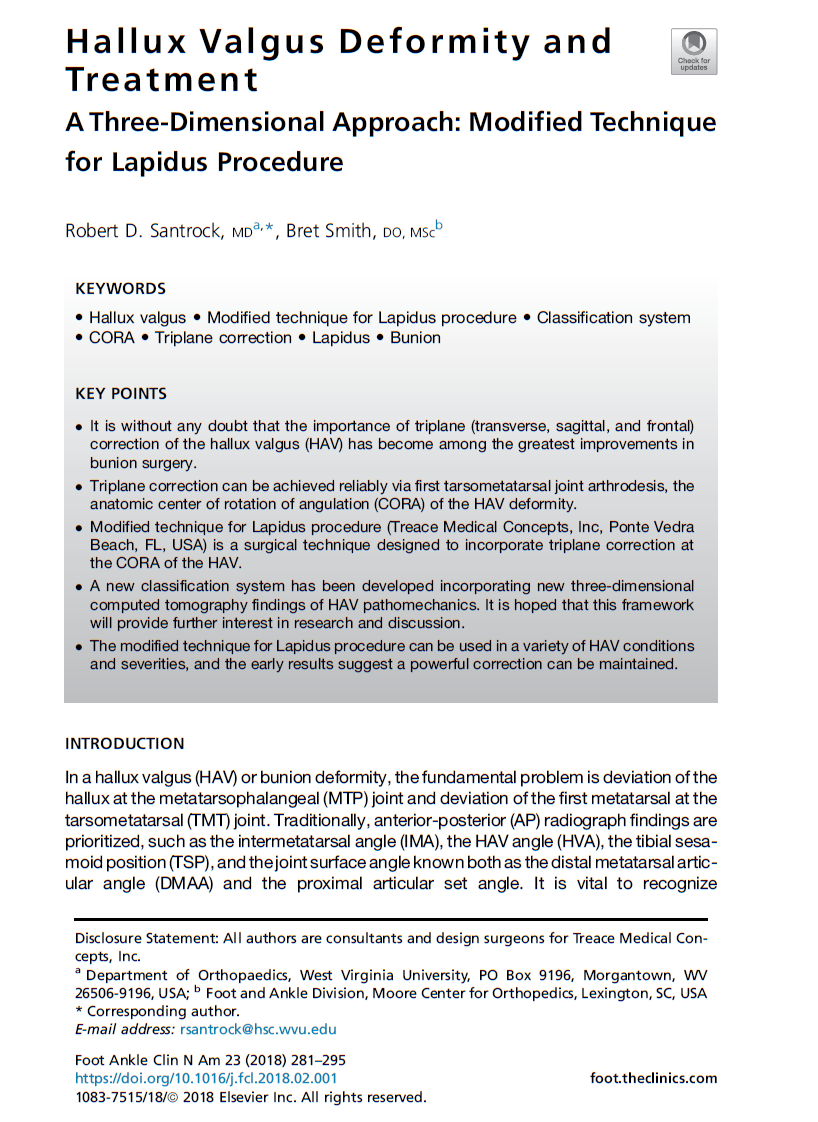
Hallux Valgus Deformity and Treatment. A Three-Dimensional Approach: Modified Technique for Lapidus Procedure
Santrock RD, Smith B
Foot Ankle Clin. 2018, 23:281-295.
Summary: Manuscript reviews the 3-plane hallux valgus classification system, the novel surgical steps of the Lapiplasty® Procedure, the Lapiplasty® Biplanar™ plating biomechanical results, and presents clinical outcome data from a 49-patient multicenter study demonstrating 96% maintenance of 3-plane correction and 0% non-union rate at 4 months following an immediate weight-bearing protocol with the Lapiplasty® Procedure.
Link
Santrock RD, Smith B
Foot Ankle Clin. 2018, 23:281-295.
Summary: Manuscript reviews the 3-plane hallux valgus classification system, the novel surgical steps of the Lapiplasty® Procedure, the Lapiplasty® Biplanar™ plating biomechanical results, and presents clinical outcome data from a 49-patient multicenter study demonstrating 96% maintenance of 3-plane correction and 0% non-union rate at 4 months following an immediate weight-bearing protocol with the Lapiplasty® Procedure.
Link

Understanding Frontal Plane Correction in Hallux Valgus Repair
Smith WB, Dayton P, Santrock RD, Hatch DJ
Clin Podiatr Med Surg. 2018, 35:27-36.
Summary: Manuscript challenges traditional two-dimensional (2D) evaluation and management of the hallux valgus deformity, presenting a 3-plane hallux valgus classification system and the detailed surgical technique steps of the novel Lapiplasty® Procedure for triplanar hallux valgus correction.
Link
Smith WB, Dayton P, Santrock RD, Hatch DJ
Clin Podiatr Med Surg. 2018, 35:27-36.
Summary: Manuscript challenges traditional two-dimensional (2D) evaluation and management of the hallux valgus deformity, presenting a 3-plane hallux valgus classification system and the detailed surgical technique steps of the novel Lapiplasty® Procedure for triplanar hallux valgus correction.
Link
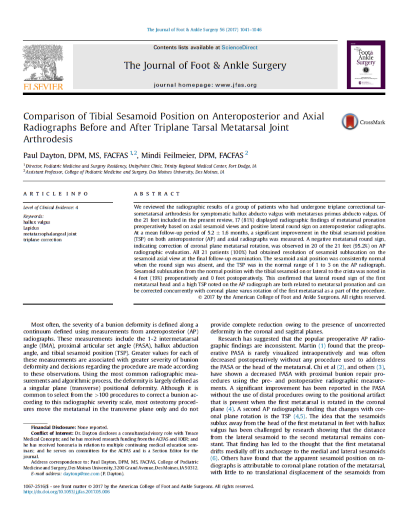
Comparison of Tibial Sesamoid Position on Anteroposterior and Axial Radiographs Before and After Triplane Tarsal Metatarsal Joint Arthrodesis
Dayton P, Feilmeier M
J Foot Ankle Surg. 2017, 56:1041-1046.
Summary: Clinical study of 21 feet at 5.2 month average follow-up demonstrating the ability of the Lapiplasty® Procedure to successfully correct the three-dimensional (3D) deformity (including metatarsal frontal-plane rotation) in 95.2% of cases, and also restore the intermetatarsal angle to 5.5°, hallux valgus angle to 7.3°, and tibial sesamoid position to 1.8.
Link
Dayton P, Feilmeier M
J Foot Ankle Surg. 2017, 56:1041-1046.
Summary: Clinical study of 21 feet at 5.2 month average follow-up demonstrating the ability of the Lapiplasty® Procedure to successfully correct the three-dimensional (3D) deformity (including metatarsal frontal-plane rotation) in 95.2% of cases, and also restore the intermetatarsal angle to 5.5°, hallux valgus angle to 7.3°, and tibial sesamoid position to 1.8.
Link
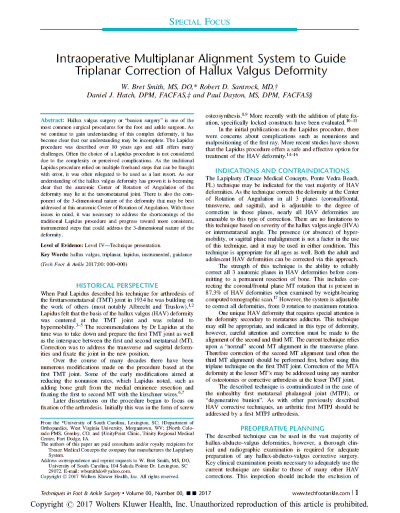
Intraoperative Multiplanar Alignment System to Guide Triplanar Correction of Hallux Valgus Deformity
Smith WB, Santrock RD, Hatch DJ, Dayton P
Techniques in Foot & Ankle Surgery. 2017, 16:175-82.
Summary: Manuscript presents a novel, instrumented approach to 3-plane (3D) Lapidus fusion (Lapiplasty® Procedure) for correction of the hallux valgus deformity, including indications/contraindications for 3-plane Lapidus arthrodesis, 3-plane x-ray views for preoperative planning, detailed surgical technique steps of the novel, instrumented Lapiplasty® Procedure, and potential complications.
Link
Smith WB, Santrock RD, Hatch DJ, Dayton P
Techniques in Foot & Ankle Surgery. 2017, 16:175-82.
Summary: Manuscript presents a novel, instrumented approach to 3-plane (3D) Lapidus fusion (Lapiplasty® Procedure) for correction of the hallux valgus deformity, including indications/contraindications for 3-plane Lapidus arthrodesis, 3-plane x-ray views for preoperative planning, detailed surgical technique steps of the novel, instrumented Lapiplasty® Procedure, and potential complications.
Link
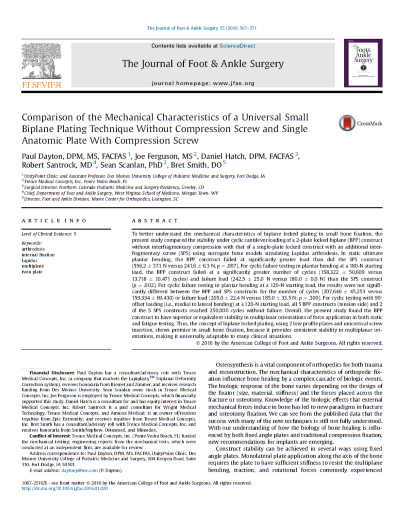
Comparison of the Mechanical Characteristics of a Universal Small Biplane Plating Technique Without Compression Screw and Single Anatomic Plate with Compression Screw
Dayton P, Ferguson J, Hatch D, Santrock R, Scanlan S, Smith B
J Foot Ankle Surg. 2016, 55:567-71.
Summary: Biomechanical study comparing Lapiplasty® Biplanar™ Plating to a commonly-used anatomic plate and screw Lapidus fixation construct, demonstrating significant improvements in biomechanical performance under maximum load to failure and cyclic loading (simulating post-operative weight-bearing).
Link
Dayton P, Ferguson J, Hatch D, Santrock R, Scanlan S, Smith B
J Foot Ankle Surg. 2016, 55:567-71.
Summary: Biomechanical study comparing Lapiplasty® Biplanar™ Plating to a commonly-used anatomic plate and screw Lapidus fixation construct, demonstrating significant improvements in biomechanical performance under maximum load to failure and cyclic loading (simulating post-operative weight-bearing).
Link
